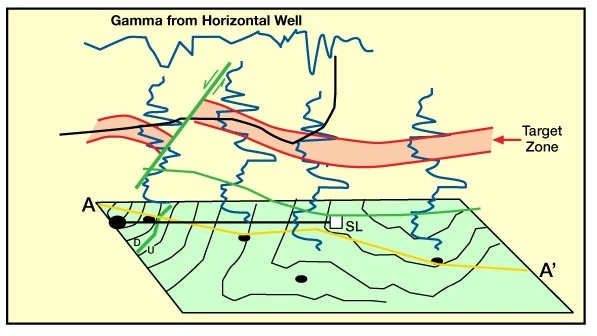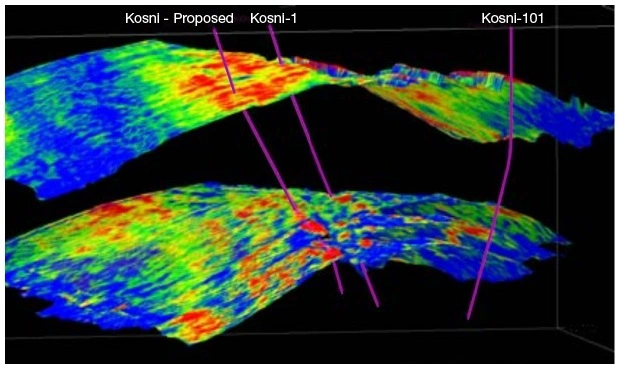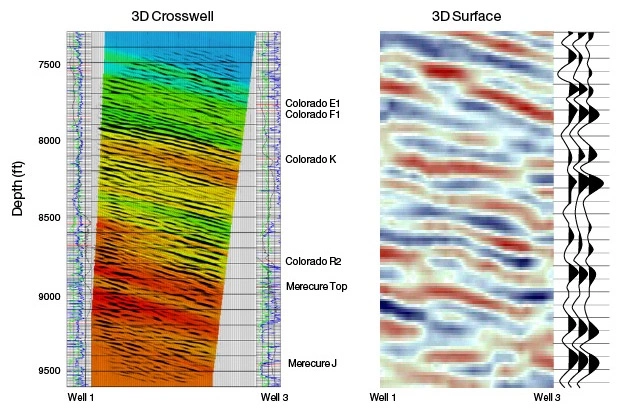Learning Objectives
After completing this topic “Introduction to Seismic Interpretation“, you will be able to:
- Define the ultimate goal of seismic prospecting.
- List the four basic steps in structural seismic interpretation.
- Identify where to pick the horizon on the seismic waveform and why.
- Describe why we initially follow the practice of timing at regular intervals of reflection time.
- Explain why migration changes the reflection times on dip lines, but does not change them on strike lines.
Introduction to Seismic Interpretation
The ultimate goal of seismic prospecting is to map certain features of the subsurface that can be identified as geologically significant in order to locate oil and gas targets for economical production.
Seismic data is acquired by field crews during the acquisition phase using highly specialized equipment that records acoustic reflections of the subsurface. The main characteristics of seismic data are:
- It is band limited the low end is 5-10 Hz and the high end is 50-100 Hz.
- Subsurface spatial coverage is redundant yet incomplete.
- It produces large data volumes (up to tens of terabytes) with:
- 2000-4000 time samples per trace
- 6-12 second record length
- 100,000-1,000,000 spatial locations
- 12-1,000 fold redundancy
- Most seismic reflection techniques use only compressional waves because these are easier to acquire, resolution and data quality are generally better, and they are more sensitive to fluid properties.
The use of shear and converted wave data is increasing in seismic acquisition because these waves may provide good images where compressional data cannot. These waves are sensitive to porosity and insensitive to pore fluid, and can be combined with compressional data, which provides more information about rock and fluid properties.
As seen by seismic waves, earth properties are:
- Inhomogeneous
- Attenuative
- Anisotropic
- Porous
- Fluid filled
After acquisition, data processing produces images of the surface in time. The seismic reflections are then analysed (which is known as interpretation) in terms of geological elements. Interpretation is the conclusive process in seismic prospecting.
Good quality seismic data can contribute extensively to the definition of some key subsurface characteristics and properties, for example:
- Depth
- Geologic setting – origin of rocks/fluids
- Geologic structure
- Geometry – thickness, areal extent, volume, and seals
- Rock type
- Heterogeneity – layering, faults/fractures, and compartments
- Porosity
- Fluid content/distribution
- Pressure distribution
- Mechanical strength
- Permeability
- Drive mechanisms
- Temperature
The objective of seismic acquisition and processing is the accurate interpretation of seismic data. This includes the analysis and understanding of signal travel times, amplitudes, attributes, and ties to subsurface controls. Interpretation is complicated by several elements, including (to name a few):
- Noise or reflections from non-geological features
- Velocity variations in depth and lateral extent
- Variations of reflection angles
- Weak or discontinuous reflections
Seismic interpretation is performed to understand subsurface structures, stratigraphy, lithology, fractures, pressure, pores, and fluids. Structural interpretation is the analysis of the geometry of the reflectors, whereas stratigraphic interpretation is mainly concerned with the character of the reflections that are related to lithology and depositional environment. The identified reflections are finally presented as depth profiles, depth contour maps, thickness maps, etcetera.
Seismic data is the only lateral continuous information available for the subsurface. It provides an important basis for the up and down scaling process, to match the actual geology, or the simulator properties, or lithologic details.
Seismic data resolution provides a link between reservoir simulations and well logs. Following are the typical resolutions for different data types:
- Simulations: hundreds of meters
- Seismic data: tens of meters
- Well logs: centimeters to meters
- Core samples: fractions of a centimeter
Figure 1 is a graphical representation of the scaling process of geological characterization.

Process of Seismic Interpretation
Seismic interpretation is the connection between geology and geophysics, where the truth about the subsurface environment becomes evident.
As explained in the video, there are four basic steps in structural seismic interpretation:
- Picking: Identifying the horizon (the top surface of a rock layer) to be mapped. The structure can be defined, along the line of the section, by making measurements of the depth of the reservoir below the datum.
- Timing: Measurement of the reflection time from the datum to the picked reflection.
- Posting: Transferring the measured reflection times to the map. The depth values can be posted at the corresponding shotpoints on a shotpoint location map.
- Contouring: Showing the structure or the relief of the chosen horizon on the map. The maximum hydrocarbon content is then defined by the spill-point contour, for example, the oil-water contact (OWC) shown in Figure 2. The closure and the maximum area of pay can be read from the map.

There are several important principles related to the geological message in the seismic trace. The seismic method measures only physical properties and their changes; geological properties can be obtained only by inference.
Reflections evident on a seismic section have a time and a character:
- The reflection time is an expression of the depth and dip of a geological surface, and of the velocity to it. That surface, in almost all cases, locally approximates the surface of the solid earth at some time in the past; thus it may be a bedding plane (representing a one-time surface of deposition) or a local portion of an unconformity (representing a one-time surface of erosion or non-deposition).
- Studies of reflection time allow us to see the folding and faulting of a geological surface, and therefore, to recognize structural traps. Further, they allow us to see angular unconformity between two surfaces so we can recognize truncation and erosion. They also allow us to see patterns of surfaces so we can identify certain depositional mechanisms; from these, in turn, we can make inferences about facies.
- The reflection character is a combination of amplitude, waveform and polarity. It is an expression of the physical properties above and below the reflecting surface, and of interference between reflections from closely-spaced reflecting surfaces.
- Studies of reflection character allow us to map variations in the nature of the rocks, to supplement our inferences about their type and condition.
With respect to basic seismic interpretation, our primary concern is with studies of reflection time, and with the correct representation of geological surfaces. This is of paramount importance, of course, to the location of structural traps. Thereafter, we may pay more and more attention to reflection character, and to its implications for stratigraphic traps.
 Petro Shine The Place for Oil and Gas Professionals.
Petro Shine The Place for Oil and Gas Professionals.



